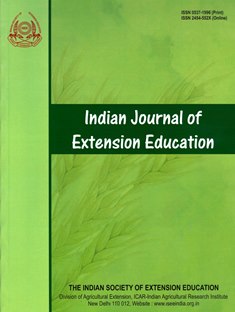Socio-economic Determinants Influence on NiliRavi Buffalo Farmers Choice of Milk Marketing Channels in Punjab
DOI:
https://doi.org/10.48165/IJEE.2023.59123Keywords:
NiliRavi, Marketed surplus of milk, Binary logistic model, Milk marketing channels, Dairy farmersAbstract
A total of 120 NiliRavi buffalo farmers from two districts of Punjab were selected for the study. The average production, consumption and marketed surplus of the milk are found to be higher for the Firozpur farmers in comparison with their counterpart. About 70 per cent of NiliRavi farmers preferred organised marketing channels to dispose surplus milk. The distance of dairy cooperatives (Govt. or Private) / dairy FPOs with regular & assured market and support in availing loan for purchase of animals and inputs were main reasons for opting organised marketing channels. Advance payment for purchase of inputs and door step milk collection were important factors for choosing unorganised milk marketing channels. The results of binomial logistic regression revealed that Nili-Ravi farmer with younger age and large number of NiliRavi milch buffalo holdings preferred organised milk marketing channels to dispose surplus milk rather than unorganised channels. The organised milk marketing channels needs to be strengthened and promoted for regular and assured milk marketing and also use these channels as centre for the supply of NiliRavi superior germplasm to propagate their population.
Downloads
References
Brar, R. S., Kaur, I., Singh, V. P., & Kaur, N. (2018). Factors affecting choice of milk marketing channels by dairy farmers in Punjab. Journal of Krishi Vigyan, 6(2), 123-29.
Buffalopeedia; http://www.buffalopedia.cirb.res.in/index.php?option= com_content&view=article&catid=47%3Amurrah&id=99%3Aorigin a-breeding-tract&Itemid=68&lang=en.
Dhanda, S., Yadav, A., Yadav, D. B., & Chauhan, B. S. (2022). Emerging issues and potential opportunities in the rice–wheat cropping system of north-western India. Frontiers in Plant Science, 13. DOI:10.3389/fpls.2022.832683
Garrett, E. H., & Woodworth, R. S. (1969). Statistics in Psychology and Education. Vakils, Feffer and Simons Pvt. Ltd. Bombay. Gogoi, J., Buragohain, R., & Deka, N. (2022). What motivates rice farmers to adopt hybrid rice technology in Assam, India? Indian Journal of Extension Education, 58(3), 74-77.
GoI (Government of India). (2019). 20th Livestock Census. Department of Animal Husbandry and Dairying, Ministry of Agriculture, New Delhi.
GoI (Government of India). (2019). Economic survey of India 2018- 19. Department of Economic Affairs, Economic Division, Ministry of Finance, New Delhi.
GoI (Government of India). (2019). Estimated Livestock Population breed wise. Department of Animal Husbandry and Dairying, Ministry of Agriculture, New Delhi.
GoI (Government of India). (2022). Economic survey of India 2021- 22. Department of Economic Affairs, Economic Division, Ministry of Finance, New Delhi.
Government of India (2013). Income, expenditure, productive assets and indebtness of agricultural households in India, 70th round, National Sample Survey Organization (NSSO). Ministry of Statistics and Programme Implementation, New Delhi.
Islam, S., Reddy, U. K., Natarajan, P., Abburi, V. L., Bajwa, A. A., Imran, M., & Shehzad, W. (2020). Population demographic history and population structure for Pakistani Nili-Ravi breeding bulls based on SNP genotyping to identify genomic regions associated with male effects for milk yield and body weight. Plos One, 15(11), 1-24.
Karli, B., Bilgi, A., & Gill, Y. (2006). Factors affecting farmers’ decision to enter agricultural cooperatives using Random Utility Model in the South Eastern Anatolian Region of Turkey. Journal of Agricultural and Rural Development in Tropics and Subtropics, 107(2), 115-127.
Kathiravan, P., Mishra, B. P., Kataria, R. S., Sadan, D. K., & Ahlawat, S. P. S. (2007). Buffalo genetic resources of India: Nili-Ravi, Published by National Bureau of Animal Genetics Resources. Karnal, Haryana.
Kumar, M., Dahiya, S. P., Ratwan, P., Kumar, S., & Chitra, A. (2019). Status, constraints and future prospects of Murrah buffaloes in India, Indian Journal of Animal Science, 89(12), 1291-1302.
National Dairy Development Board (NDDB) https://www.nddb.coop/ information/stats/milkprodstate.
Priscilla, L., Chauhan, A. K., Lalrinsangpuii, & Nagrale, B. G. (2016). Determinants of participation of dairy farmers in dairy cooperative societies in Manipur. Indian Journal of Economics and Development, 12(2), 377-379.
Singh, V., Gupta, J., & Nain, M. S. (2014). Communication behaviour of dairy farmers: a source for milk quality improvement. Indian Journal of Extension Education, 50(3&4),78-84.
Singh, V., Gupta, J., & Nain, M. S. (2016). Role and status of antecedent characteristics of dairy farmers in quality milk production. Indian Journal of Extension Education, 52(3&4), 171-176.
Vij, P. K., & Tantia, M. S. (2005). Status of Nili-Ravi buffaloes in India. Animal Genetics Resources Information, 37, 75-81.
Downloads
Published
Issue
Section
License

This work is licensed under a Creative Commons Attribution-NonCommercial-NoDerivatives 4.0 International License.

